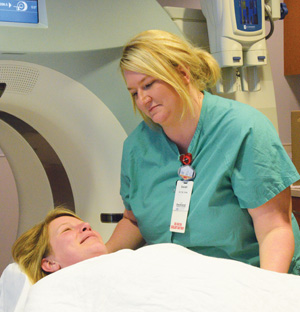 CT scanning (computerized axial tomography) -- sometimes called CAT scanning -- is a noninvasive and painless diagnostic procedure using special X-ray equipment to create cross-sectional pictures of your body. CT imaging compares to looking into a loaf of bread by cutting the loaf into thin slices. When the image slices are reassembled by computer software, the result is a very detailed multidimensional view of the body's interior, which can be viewed in seconds on a monitor.
CT scanning (computerized axial tomography) -- sometimes called CAT scanning -- is a noninvasive and painless diagnostic procedure using special X-ray equipment to create cross-sectional pictures of your body. CT imaging compares to looking into a loaf of bread by cutting the loaf into thin slices. When the image slices are reassembled by computer software, the result is a very detailed multidimensional view of the body's interior, which can be viewed in seconds on a monitor.
CT Scan Is Different from an X-ray
Conventional X-rays can’t differentiate bone, tissue, fat, gas and other organs, but a CT scans helps physicians examine soft tissues and internal organs. CT scans are used to diagnose medical conditions and as a rapid diagnostic tool for traumatic injuries.
Preparing for Your Test
You should wear comfortable, loose-fitting clothing. In some cases you will be given a gown to wear during the procedure. Metal objects including jewelry, piercings, eyeglasses, dentures, hearing aids, removable dental work and hairpins may affect the images and should be removed prior to your exam.
You will be given instructions about eating or drinking beforehand. Take prescribed medication as directed unless instructed otherwise by your physician.
You may be asked to fast if contrast material (dye) is used for the test. Inform your physician of any allergies, recent illnesses or medical conditions. If you have an allergy to contrast material (dye) your doctor may prescribe medicine to reduce the risk of reaction.
Women should always inform their physician and the CT technologist if there is any possibility that they are pregnant.
The Procedure
A technologist helps you on the screening table and makes you comfortable. Once the exam begins, you are asked to remain still for the duration. The technologist goes to the control room, but watches you through a window and remains in contact through an intercom. During the test, you lie on a table that passes slowly through the center of a large doughnut-shaped X-ray machine.
For some tests, you receive a contrast material (dye) intravenously that makes parts of your body show up better. If dye is used, you may feel a hot flushed sensation. This is normal and will pass within a few seconds.
The test takes 15-30 minutes.
About Contrast Material
If contrast material (dye) is necessary, a nurse or technologist inserts an intravenous line into a vein in your hand or arm. In some cases you are given a drink containing the contrast material.
In rare cases, people have an allergic reaction to the contrast. Having your procedure at a hospital ensures monitoring and immediate treatment if this should occur.
The contrast consists of iodine or barium. When injected, it contrasts with the air and tissues within the body, allowing for easier viewing. Some people may experience a warm sensation when the dye is injected, followed by a metallic taste in the mouth -- both of which are harmless and common.
If you are given a drink containing the contrast material, diarrhea may develop within a few days after the scan, especially with iodine-based contrast.
People with diabetes usually experience problems with the contrast material. Those with known allergies to iodine or barium need to inform both their physician and technologists before receiving any contrast material.
Unusual symptoms that develop after receiving the contrast -- during or after the exam -- should be reported to the technologist immediately.
If You Have Claustrophobia
If you have claustrophobia (fear of enclosed spaces) or anxiety, you may want to ask your physician for a mild sedative. Some machines, such as the open MRI or the open-bore MRI -- both offered at Parkland Health Center -- are more appropriate for people with this condition.
After Your Test
When the exam is finished, you may be offered a CD that contains your images. These are for your personal records.
With the advanced software at Parkland Health Center, your physician has access to your images and clinical information almost immediately. Your images are read by a radiologist, and your physician has a full report in 24-48 hours. Your physician contacts you regarding the results.
CT Scans for Children
Your child will be alone in the exam room during the CT scan. The technologist can hear and speak with him/her at all times. A parent may be allowed in the room, but will be required to wear a lead apron to prevent radiation exposure. Dress the child in comfortable clothing. Bring along his/her favorite toy or blanket to provide some reassurance.
It can be hard for children to keep still when they are not feeling well. Because a successful CT requires the patient to remain completely still during the exam, children under 6 may need to be sedated.
An IV needle is inserted in the child's arm in preparation for sedation, but this is usually the worst part of the experience.
If the child needs sedation, he or she may have to stay up to two hours after the exam for observation.